Gringo in Brasil
BRAZILIAN ADVENTURE
A Gringo's Impression of Brazil (1992)
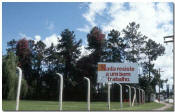 "Nada
resiste a um bom travalho," (don't oppose a good job) was the
billboard that greeted me while exiting the Porto Alegre airport in
southern Brazil (it is spelled "Brasil" when in the country). The
sign seemed appropriate to my circumstance. The day before while
working as a paralegal in Denver, Colo. an acquaintance called. When
he said, "You are the highest time 400LS pilot alive today," I
wondered what happened to the others. He asked if I could go to
Porto Alegre and fly for a week. They needed a pilot to demonstrate
a Cheyenne 400LS to a prospective buyer.
"Nada
resiste a um bom travalho," (don't oppose a good job) was the
billboard that greeted me while exiting the Porto Alegre airport in
southern Brazil (it is spelled "Brasil" when in the country). The
sign seemed appropriate to my circumstance. The day before while
working as a paralegal in Denver, Colo. an acquaintance called. When
he said, "You are the highest time 400LS pilot alive today," I
wondered what happened to the others. He asked if I could go to
Porto Alegre and fly for a week. They needed a pilot to demonstrate
a Cheyenne 400LS to a prospective buyer.
After bumming around for a couple of years after the oil company I flew for went out of business, I wasn't about to "resist a good job." This one-week job turned into nearly five months of fantastic flying in Brasil.
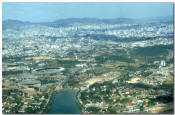 José
Vargis, a pilot, picked me up at the airport and dropped me off at
the Hotel Plaza San Rafael in downtown Porto Alegre. Out of
curiosity, one of the first things I did in Brasil was flush the
toilet. Boy was I disappointed. For years and years everything I
read about flying south of the equator indicated the low pressure
area rotates clockwise. Imagine my surprise as the water flowed
counterclockwise just like in the United States. It turned out some
fantastic salesman got rid of a batch of toilets during the
construction of the hotel. The North American toilet had water jets
directing the flow counterclockwise. The toilet did not flush very
good.
José
Vargis, a pilot, picked me up at the airport and dropped me off at
the Hotel Plaza San Rafael in downtown Porto Alegre. Out of
curiosity, one of the first things I did in Brasil was flush the
toilet. Boy was I disappointed. For years and years everything I
read about flying south of the equator indicated the low pressure
area rotates clockwise. Imagine my surprise as the water flowed
counterclockwise just like in the United States. It turned out some
fantastic salesman got rid of a batch of toilets during the
construction of the hotel. The North American toilet had water jets
directing the flow counterclockwise. The toilet did not flush very
good.
Bathtubs are rare, even in expensive hotels; but you will find a bidet everywhere. The soap provided as a gratuity and convenience by the hotels failed to lather. There were no suds or other indication that it was working at all. Most homes and many hotels do not have hot and cold running water. To compensate, a shocking electrical device (pun intended) is attached to the showerhead to heat the water. Usually bare wires dangle from the ceiling to this apparatus. The water temperature is adjusted by changing the water flow.
Belo Horizonte – Para meus amigos de Brasilian: Eu tive um tempo maravilhoso em Brasil e conheci muitos amigos novos. Nada nestes páginas é significando ser derrogatório a Brasil ou as pessoas maravilhosas dela. Se algo o aborrece, por favor me deixe saber assim eu posso mudar isto. Obrigado e abraços. Sparky
FLYING
Flying over the countryside of Brasil is not unlike anywhere else, it's just that there's more of it. Much more. Brasil is a big country. It's highest mountain, Pico da Nebilina at 9,888 feet is located northwest of Rio de Janeiro. Brasil does not have the mountain flying we enjoy in the American West. Aerodynamically Brasil isn't different either; if you want to go up, pull back on the control wheel ... to go down, pull back farther.
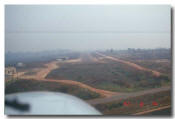 |
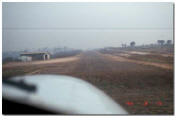 |
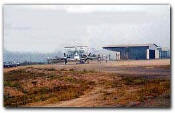 |
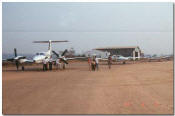 |
| Cocoal - final approach for landing | Cacoal - short final | Cheyenne 400LS at Cacoal | The people were fascinated by the big propellers on the 400LS |
OVER-FLIGHT PERMIT
All private aircraft overflying or landing in Brasil (and most other South American countries) for non-commercial purposes must give at least 24 hours prior notice to both the Department of Civil Aviation and the Airport of landing. This notification does not become valid until you receive a return acknowledgement. It is then necessary to carry this document aboard the aircraft during flight into or across Brasilian territory. Yes, they do check it at every tower-controlled airport, and you can't file a flight plan without it. A passport and visa are required. Don't try to fly into Brasil and then obtain the Visa at the first airport of landing. The Visa must be obtained prior to entering the country.
PROCEDURES
Discounting a couple of flight, the procedures for flight were the same at the States. At tower-controlled airports, the controllers speak good English. The practice of listening to ATIS, calling clearance delivery, ground control, tower, departure and center is all the same. One thing that is different is that the Brasilians use of a transition altitude. In the States the transition altitude is FL180, where the altimeter is adjusted to 29.92" Hg. on ascent, then adjusted to the current reported altimeter setting on descent through FL180. In Brasil, these changes are made at variable transition altitudes. This altitude is found on the instrument approach charts and may be 2,500 feet, 4,000 feet, or some other such altitude. You have to check for the area you are flying.
LANDING FEES
Non-Brasilian registered airplanes must pay a tax (rate) after landing at tower-controlled airports to help pay for airway services (navaid maintenance and communications). These airports have a large black sign with the letter "C" painted in yellow near the entrance to the facilities. This is the designation for A.I.S. (Air Information Services). Not only does this designate the location of customs and weather, but also a bureaucratic government entity called Infraero. The rate will range from US$75 to US$750 for general aviation airplanes. The rate for the Cheyenne 400LS was about US$400, but we found a way to cut this in half. File a flight plan (it has to be filed before the rate can be paid) to a tower-controlled-destination airport and while en route, change the destination to a non-tower controlled airport (assuming it was your original intent to fly to a non-tower controlled airport.
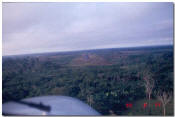 |
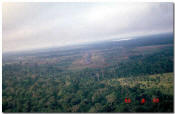 |
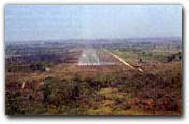 |
| Ji-Parana final approach to runway 20 |
Ji-Parana final approach to runway 20 |
Ji-Parana final approach to runway 20 |
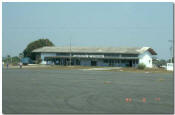 |
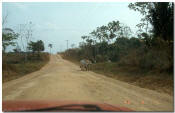 |
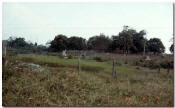 |
| Ji-Parana Terminal | Road to town | Termite mounds |
MAINTENANCE
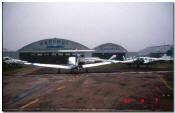 Here
the airplane (Piper Cheyenne 400LS) is parked at Aeromot, a
maintenance facility located at the Porto Alegre airport. I was
astounded by the quality of workmanship in Brasil that was performed
by mechanics with little or no equipment. It is literally amazing to
see them perform. They fabricated metal and fiberglass parts that
were better than the original. The major maintenance was performed
in Porto Alegre and Sorocaba.
Here
the airplane (Piper Cheyenne 400LS) is parked at Aeromot, a
maintenance facility located at the Porto Alegre airport. I was
astounded by the quality of workmanship in Brasil that was performed
by mechanics with little or no equipment. It is literally amazing to
see them perform. They fabricated metal and fiberglass parts that
were better than the original. The major maintenance was performed
in Porto Alegre and Sorocaba.
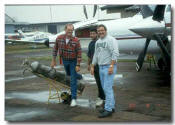 Sam
Snyder (left), Mario Amaral (center), and Lenny Baldwin (right)
performed maintenance on the 400LS. Sam and Lenny were from Ft.
Lauderdale, Florida, while Mario was from Porto Alegre and worked
for Aeromot.
Sam
Snyder (left), Mario Amaral (center), and Lenny Baldwin (right)
performed maintenance on the 400LS. Sam and Lenny were from Ft.
Lauderdale, Florida, while Mario was from Porto Alegre and worked
for Aeromot.
MOTELS
After flying all-day and landing at one of the various towns or cities you might ask, without thinking (or knowing) for the name of a good motel. Don't The motel is a Brasilian institution regarded by Brazilians with indifference. It functions as a sex hotel, renting rooms by the hour for short stays, to provide privacy in an area of overcrowded living conditions.
COMMUNICATIONS
On his first flight my non-English speaking Brasileiro pilot communicated with his gringo friend (not a derogatory term) using four words. After starting the engines of the 400LS, I asked the co-pilot to read the taxi checklist. He said, "Okay," and continued looking at all the buttons, whistles and bells on the airplane he had never been in before. After the taxi, when nothing happened, I asked him to go through the before takeoff checklist. He said, No problem." Still no response other than his running his fingers lightly over the various knobs and switches. After going through the checklist myself, we made a maximum performance "show off-impress you" takeoff (rotate to 30 degrees of pitch and hold it. It's not necessary to get the nose down to prevent a stall with this rocket. The next word out of his mouth was a drooling, "Incrivel."
WEATHER SERVICES
Weather services in Brasil are primitive. U.S. pilots are spoiled, being able to obtain weather by computer, telephone, FAX and radio. In Brasil the normal procedure is to visit the military weather office. Just like in the U.S. if you say, "How's the weather to Sorocaba?" you'll receive an answer of "Okay" or "No problem." (I have yet to hear "incrivel.") Instead, ask for the current weather, forecast weather, hazardous weather and winds aloft. As a rule they won't have it, but they'll gladly grab the telephone and get it. Even when the Teletype is down, they will call the actual stations and obtain the weather. They are very friendly and helpful.
AIRCRAFT RENTALS
If you want to rent a Brasilian registered airplane, you must have a Brasilian pilot certificate. "No problem." Upon presentation of your currently valid pilot certificate, medical certificate and passport, you will be issued a Brasilian private pilot certificate, with the ratings of your current certificate (except glider). Issuance of any grade certificate higher than a private requires a written and flight test along with a certificate of need stating why you will be taking jobs away from Brasilian pilot by flying commercially.
HOLIDAYS
It seemed like every other weekend in Brasil was a holiday of some sort or another. If you need to shop and the weekend is approaching, check on Thursday to find out if you need to shop on Friday because the stores close for holidays.
MEMORABLE FLIGHT
November 4th turned into my most memorable flight from Porto Alegre. Thankfully it was solo. Normally I do not and will not fly an airplane after an annual inspection without a daytime, good-weather test flight. But after being told the airplane would be delivered to Cascavel (359 degrees magnetic and 334 nautical miles) that night or the deal to sell it would be squelched, I decided to make the flight. After all, I had flown this particular about 100 hours with no major problems.
Bill Clinton may have won by a landslide this day, but I didn't come out in first place in the flight department. After takeoff, in the dark and entering clouds at 300-feet AGL, the radios quit ... period. No VOR, no ADF, no KNS-660, and the flux gates had been swapped to fix a heading problem, which resulted in the #1 HSI (horizontal situation indicator) being off 49 degrees and the #2 HSI was off minus 33 degrees.
By frequently turning the windshield heat off, the compass could be checked to determine an approximate heading. Unknown to me, two partial holes had been punched in the baggage door pressure seal during some fillet work. A fairly rapid depressurization occurred when the seal blew during the climb through FL280. The pressurization ECU (environmental control unit) was cycled to Hi until the bleed air overtemp annunciator required turning it back to low. This was done back and forth to prevent the oxygen masks from deploying from the ceiling. It didn't seem right to arrive, assuming I could find the airport, with masks dangling all over. Besides it's an intolerable struggle for me to get the darn masks stowed. The hi-to-lo cycles were casing the cabin pressure to fluctuate, at about 6,000 feet per minute, maintaining a 7,000 to 10,500-foot cabin altitude. All I could think was, "No problem."
I would like to think it was my exceptional piloting skills, gained from flying during the past 25 years that saved the day. But it was probably dumb luck that allowed me to descend through the clouds after what was determined to be the appropriate time interval, to discover a city with an airport that was oriented properly. So I landed.
I have heard of pilot becoming lost and after landing they ask the name of the airport. I was tempted to ask what country I was in. It turned out to be Cascavel.
DIVERSIONS
The pronunciation of Português for me and English for the Brasilians sometimes created hilarious diversion. Wile working on the airplane one day, Vargas came up and said the C.T.A. (Brasilian FAA) was inspecting a friend's airplane for import and asked if he could borrow what sounded like the "sur ve vulke." I asked him to repeat it several times before he, in frustration, went to the nose of the airplane and removed the "survival kit." Another word that fooled me for a while was "kino," which translates to "do you know."
CASCAVEL
Flying from Porto Alegre to Cascavel one dark and stormy night turned into another of those days when I should have stayed in bed. My co-pilot must have entertained the same thought. Immediately after takeoff, as we entered the clouds, the left tip tank fairing slipped and wedged against the left aileron. At high speeds (about 400 mph) the one-quarter inch aileron movement provided some control, but when we slowed, only rudder would provide a bank.
Next we were just about to level off at FL280 when a brilliant arc appeared around the right engine. A rock had punctured the rubber coating of the prop-de-ice boot allowing a wire to short and arc. The NDB approaches were interesting without aileron control. On the third approach we were able to bank sufficiently to keep the airport in sight and make a splash down on the rain-soaked runway.
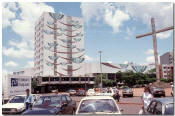 Cascavel
(meaning rattlesnake or brave) is a relatively new city being about
35-years-old. Here, as in other places, we were cautioned about
walking around at night. Without
Cascavel
(meaning rattlesnake or brave) is a relatively new city being about
35-years-old. Here, as in other places, we were cautioned about
walking around at night. Without
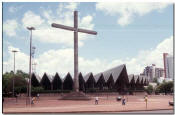 personal
possessions like cameras, watches and rings we walked throughout the
city without any problem. I spent a lot of time staying at the
Palace Verdes Hotel and had to opportunity to attend the Catholic
Church next door to the hotel several times.
personal
possessions like cameras, watches and rings we walked throughout the
city without any problem. I spent a lot of time staying at the
Palace Verdes Hotel and had to opportunity to attend the Catholic
Church next door to the hotel several times.
The Palace Verdes Hotel (left) and Catholic Church (right)
COSTA MARQUES
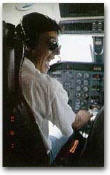 José
Vargas was the pilot (and a darn good pilot) on a flight from Ji-Paraná
to Costa Marques. We diverted to a swamp/marsh area to the south
along the Rio Guaporé near Pôsto Fiscal Rolim de Moura so that our
passengers, including the president of a bank in Japan, could survey
some property. We had not filed an IFR flight plan because the
weather was good and we thereby avoided the "rate" charged for
airway services. As a consequence air traffic control did not turn
on the NDBs; their effort to save electricity and wear-and-tear on
the facilities.
José
Vargas was the pilot (and a darn good pilot) on a flight from Ji-Paraná
to Costa Marques. We diverted to a swamp/marsh area to the south
along the Rio Guaporé near Pôsto Fiscal Rolim de Moura so that our
passengers, including the president of a bank in Japan, could survey
some property. We had not filed an IFR flight plan because the
weather was good and we thereby avoided the "rate" charged for
airway services. As a consequence air traffic control did not turn
on the NDBs; their effort to save electricity and wear-and-tear on
the facilities.
There are no other navigational aids in this area. The King KNS-660 radio is updated by VLF/Omega, VOR/VOR, VOR/DME or DME/DME. It had not been updated for a period of time (and couldn't be). It turned out to be a little inaccurate.
After arriving at Costa Marques, according to the KNS-660, there was no town, only jungle, rivers and a large lake. I checked the WAC chart to try to determine where we were located. The WAC charts are hard to find, outdated by three years, and covered a small area. I suspected we were in Bolivia ... without an overflight permit. José happened to have a book listing commercial broadcast stations. With a couple of cross bearings on the ADF we found we were near Lago De San Luis (and shouldn't have been there).We computed a new heading and arrived at Costa Marques after flying another 50 miles at low altitude to avoid radar.
It didn't seem to matter where we went or the time of day or night, José had a propensity for "a aterragemé como borboleta com pé machucado," that is, making a landing like a butterfly with sore feet.
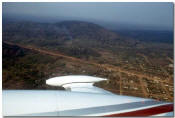 Small hill at Costa Marques |
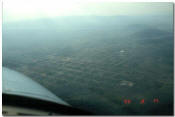 Airport to the left of the small hills |
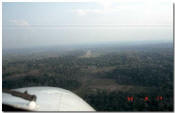 Final approach |
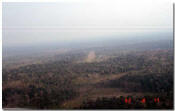 Final approach |
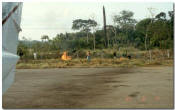 Burning underbrush |
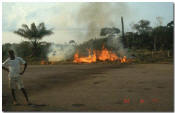 The fire spread quickly |
Costa Marques is a little primitive. Driving along
the dirt streets contributed huge plumes of dust to the already
smoke-filled sky that resulted from burning in Peru and Bolivia.
That evening while walking along the river we were warned not to
drink the water because there had been five deaths due to cholera
during the day.
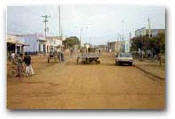 Costa
Marques is a little primitive. Driving along the dirt streets
contributed hugh plumes of dust to the already smoke-filled sky that
resulted from burning in Peru and Bolivia.
Costa
Marques is a little primitive. Driving along the dirt streets
contributed hugh plumes of dust to the already smoke-filled sky that
resulted from burning in Peru and Bolivia.
That evening, while walking along the river we were warned not to drink the water, as there had been five deaths due to cholera during the day.
Street scene in Costa Marques
|
|
|

